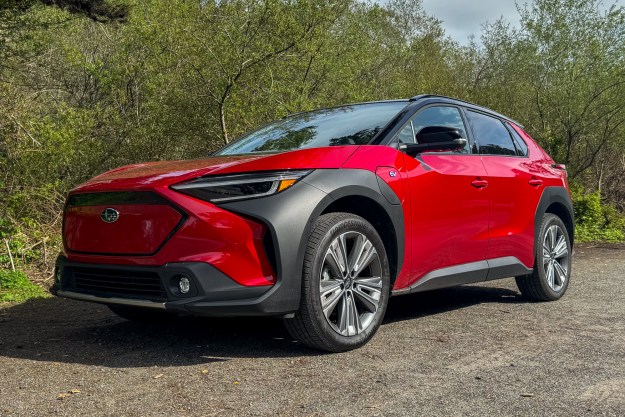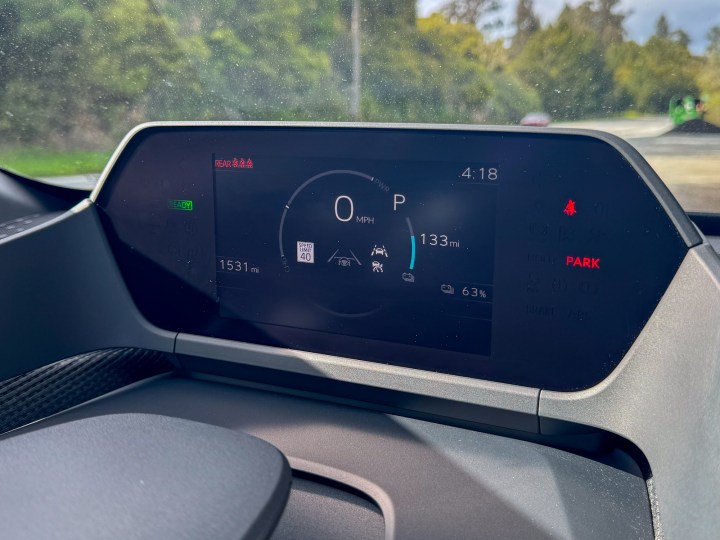
“The Subaru Solterra has a top range of 227 miles on the lowest-end Premium trim. This simply isn't good enough.”
- AWD standard
- Spacious interior
- Good amount of storage
- Limited range
- Slow charging speed
- Not the most performant

Subaru is finally getting into the EV game. The Subaru Solterra is built to usher Subaru into the age of electric cars, offering all the benefits of an electric car but with those rugged features that customers know and love about their Subarus.
And, for the most part, it succeeds. It delivers a decent driving experience, has a relatively roomy interior, and more. But, unfortunately for Subaru, it has to go up against some stiff competition — including the likes of the Tesla Model Y, Hyundai Ioniq 5, Kia EV6, and the Ford Mustang Mach-E, all of which are in a similar price bracket or cheaper.
Does it do enough? Well, perhaps for the right person — but most people buying a car this size will likely end up looking elsewhere. We took the Subaru Solterra Touring for a spin for a week to find out just how well it performs.
Design and interior
I live in California, so I see Subarus more or less every day. For the most part, they’re immediately recognizable — but the Solterra doesn’t look like any Subaru that came before it.
That’s not a bad thing, though. The Solterra isn’t the most stylish EV out there, and it perhaps doesn’t do all that much to stand out from the crowd. But it’s far from an ugly car. The Solterra has an angular build, with large black plastic wheel arches and a pointed rear.

If you’re experiencing déjà vu, you’re not hallucinating — the Solterra looks very similar to the Toyota bZ4X. In fact, apart from some minor tweaks, it’s actually the same car — as it was developed in partnership with Toyota.
The interior of the Solterra is roomy enough for a small family, and there’s a good amount of storage, including a 23.8 cubic-foot trunk. It has a digital gauge cluster that is mounted further back toward the windshield than many other cars, coupled with an 12.3-inch display for infotainment (or an 8-inch display on the base models). The driver handles the car with a square steering wheel, and I didn’t mind the feel of it — I got used to it pretty quickly.

It’s pretty comfortable, too — with plush leather-covered seats, and seat ventilation — at least in the highest-end Touring model I reviewed. I did find that some of the interior materials felt slightly cheap, with a lot of plastic throughout, but it wasn’t too bad. For the most part, the car was spacious and comfortable, which is exactly what you would expect.
Tech, infotainment, and driver assist
The Subaru Solterra isn’t necessarily the most tech-forward car out there, but there are still a few helpful features that drivers can make use of. The 12.3-inch infotainment display at the front of the car supports CarPlay and Android Auto — and you’ll likely want to use it, as Subaru’s infotainment software isn’t great. You’ll get used to the software eventually, but again, you’ll find things easier if you connect your phone. There’s a wireless phone charger at the front of the car too, and it was easily large enough for my iPhone 15 Pro Max, so most people should have no issues with its size.

The Solterra is Subaru’s most forward-facing car yet, and it does have some helpful driver-assist features. For starters, there are basic ones, like blind-spot monitoring and a backup camera — though I really dislike the fish-eye effect on the car’s backup camera. On our review model, there was also a bird’s-eye view for parking, which was quite helpful. And you’ll get things like adaptive cruise control and lane-centering. There’s even a digital rearview mirror, which can be useful for seeing behind you when tall passengers or other objects are blocking your view.
These features aren’t groundbreaking, and many aren’t available standard, so if you want them, you’ll have to upgrade to a higher-end model or add-on options. But some of them could be genuinely useful to drivers who want a slightly more tech-forward driving experience.
Driving experience
The Subaru Solterra is built to be a little more rugged than other EVs. As such, it’s only available in an all-wheel drive configuration with two motors that deliver 215 horsepower and 249 pound-feet of torque combined. There are a few different driving modes, including Eco, Normal, Power, and X-Mode, which is built more for off-roading or driving on slippery roads as it independently manages each wheel’s power.

Generally, I found driving the Solterra Touring to be a good experience. The car was relatively zippy, though not as quick as many of the competitors in this price range. Steering was relatively responsive, but again, perhaps not quite as much as the likes of the Ioniq 5. The Solterra has paddles behind the steering wheel to tweak regenerative braking, and there’s a button to enable single-pedal driving. Unfortunately, like many other cars, the Solterra won’t remember if you had single-pedal driving turned on — it’ll be off by default every time you turn on the car.
The Solterra can accelerate from 0 to 60 mph in 6.5 seconds, which isn’t all that quick, especially for a car in this price range. Competitors like the Ioniq 5 and EV6 have options for quicker acceleration, depending on the model, so if speed is important to you, it’s worth considering an alternative.
Range and charging
One area in which the Solterra lags behind the competition is in range and charging. The car has a top range of 227 miles on the lowest-end Premium trim, or 225 miles for the other two trims (Limited and Touring, which we drove). This simply isn’t good enough — especially considering the fact that there isn’t even an option for a larger battery that could make for a higher range. We would want the car to deliver a range of at least 300 miles, if not in the base model, then as an option.

The Solterra has a slow charging speed, too. Subaru says that the car can charge from 0% to 80% in around 35 minutes, with a maximum charging speed of 100 kilowatts. This is just isn’t as fast as it should be — most modern EVs support charging speeds of at least 150kW, with some getting as high as 350kW, allowing drivers to charge to 80% in under 20 minutes.
How DT would configure this car
The 2024 Subaru Solterra Touring isn’t a bad electric car, especially given the fact that the base model is all-wheel drive. However, it lags behind the competition, namely cars like the Tesla Model Y, Ford Mustang Mach-E, Kia EV6, and Hyundai Ioniq 5. It’s not as fast as these cars, it doesn’t have as long of a range, and it doesn’t charge as quickly.
If you’re still set on buying the Subaru Solterra, the Limited trim is probably the way to go. It’s not as pricey as the top-end Touring model but still has helpful comfort-related features, like heated seats and driver-assist features, like additional parking sensors.



